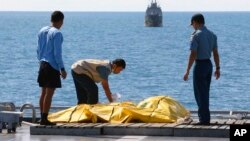A sequence of events, starting with a faulty electrical part and ending with pilot error, led to the December 2014 fatal crash of AirAsia 8501, according to Indonesian investigators. The plane was less than an hour into its flight from Surabaya to Singapore when it crashed into the Java Sea, killing all 162 aboard.
Nurcahyo Utomo of Indonesia's National Transportation Safety Committee said the investigation found a crack in the soldering on a tiny electrical part in the system controlling the plane's rudder. It had malfunctioned 23 times on the airplane in the past year and four times during this flight.
"The existing maintenance processes were not able to analyze the repetitive fault, including the four times during flight," said Utomo.
Crew response
The crew reset a circuit breaker to the electronics that control the rudder - a procedure that had worked in the past. That move, however, switched off the autopilot and the flight crew lost control of the plane in manual mode. The plane stalled and plunged into the sea.
The A320 was designed to not exceed a critical angle and stall; but, the manual mode caused the aircraft to lose its normal flight envelope and enter into a prolonged stall which, investigators say "was beyond the ability of the flight crew to recover."
Steven Wallace, former director of the FAA Office of Accident Investigation, said the airbus was the first automated "fly by wire" aircraft when it was introduced, meaning the control surfaces are driven through computers.
Automation vs. abilities
"Automation is a huge boon to aviation safety," said Wallace. "It frees up pilots to pay attention to more important issues at cruising altitude, like weather."
Wallace said its benefits can be at the expense of loss of fundamental flying. "There is a concern that flight crews flying high tech, sophisticated airplanes can lose basic flying skills," he said.
Pilots receive extensive training on take-off and landing. Statistics by Boeing show that 45 percent of all accidents occur during these times. Recently, however, analysts have questioned whether some airlines are adequately training their pilots - in the cruising autopilot mode of the flight - on how to handle a stall or catastrophic failure that requires manually flying the plane.
Questions about maintenance
Analysts are also asking why AirAsia would allow an aircraft part to malfunction 23 times without grounding the plane for further investigation. The Indonesian probe into the crash found that AirAsia's maintenance system was "not optimal."
"A strong safety culture responds to things even when they seem to be harmless," said former FAA official Wallace.
The Indonesian report's intent is not to place blame, but to make recommendations to AirAsia, Airbus and regulators to avoid similar incidents. Since the accident, AirAsia has implemented 51 improved safety measures.







